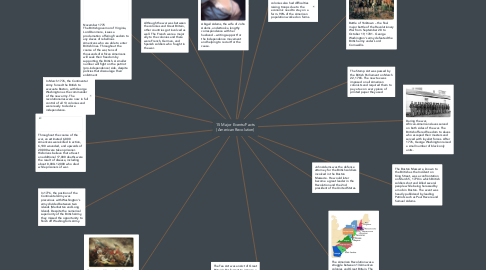15 Major Events/Facts (American Revolution)
von Irae Laban

1. There were 7 Events That Enraged Colonists and Led to the American Revolution: Stamp Act (March 1765), The Townshend Acts (June-July,1767), The Boston Massacre (March, 1770) The Boston Tea Party (December,1773), The Coercive Acts (March-June 1774) Lexington and Concord (April 1775) and British attacks on coastal towns (October 1775-January 1776)
2. Although the war was between the colonies and Great Britain, other countries got involved as well. The French were a major ally to the colonies and there were French, German, and Spanish soldiers who fought in the war.
3. Abigail Adams, the wife of John Adams, undertook a lengthy correspondence with her husband – writing support for the Independence movement and helping to recruit for the cause.
4. In 1776, the position of the Continental Army was precarious with Washington’s army divided between two islands (Manhattan and Long Island). Despite the numerical superiority of the British Army, they missed the opportunity to finish off Washington’s Army.
5. In March 1776, the Continental Army forced the British to evacuate Boston, with George Washington as the commander of the new army. The revolutionaries were now in full control of all 13 colonies and were ready to declare independence.
6. Throughout the course of the war, an estimated 6,800 Americans were killed in action, 6,100 wounded, and upwards of 20,000 were taken prisoner. Historians believe that at least an additional 17,000 deaths were the result of disease, including about 8,000–12,000 who died while prisoners of war.
7. November 1775 The British governor of Virginia, Lord Dunmore, issues a proclamation offering freedom to any slaves of rebellious Americans who are able to enter British lines. Throughout the course of the war, tens of thousands of African Americans will seek their freedom by supporting the British. A smaller number will fight on the patriot (pro-independence) side, despite policies that discourage their enlistment
8. The Tea Act was an Act of Great Britain's Parliament to impose a tax on tea and reduce the massive tea surplus of the British East India Company in London, a company in financial trouble.
9. The American Revolution was a struggle between 13 American colonies and Great Britain. The thirteen colonies were: Delaware Pennsylvania, New Jersey, Georgia, Connecticut, Massachusetts Bay, Maryland, South Carolina, New Hampshire, Virginia, New York, North Carolina, and Rhode Island.
10. During the war, African-American slaves served on both sides of the war. The British offered freedom to slaves who escaped their masters and served with loyalist forces. After 1776, George Washington raised a small number of black only units.
11. John Adams was the defense attorney for the British soldiers involved in the Boston Massacre. He would later become a great leader in the Revolution and the 2nd president of the United States.
12. Approx 42,000 British sailors deserted in the war. American colonies also had difficulties raising troops due to the economic need to stay on a farm. 90% of the American population worked on farms.
13. Battle of Yorktown – the final major battle of the Revolutionary War from September 28 to October 19, 1781. George Washington’s army defeated the British army under Lord Cornwallis.
14. The Stamp Act was passed by the British Parliament on March 22, 1765. The new tax was imposed on all American colonists and required them to pay a tax on every piece of printed paper they used
15. The Boston Massacre, known to the British as the Incident on King Street, was a confrontation on March 5, 1770 in which British soldiers shot and killed several people while being harassed by a mob in Boston. The event was heavily publicized by leading Patriots such as Paul Revere and Samuel Adams.


